Overhang
Physical balance has always fascinated me. We do it unconsciously, and yet it is an essential part of movement. Balance is what keeps us from wiping out, or from getting our legs tangled in a mess of movement. Balance let’s us reach on one leg for an item that’s just out of reach, and it also lets us do complex movements when playing sports.
However, what I described above is what you could call dynamic balance. It’s balance that’s achieved through the act of moving. Think of riding a bicycle. You’re able to balance on a bicycle because you’re pedalling the bicycle. Unless you’re really talented, you don’t find yourself balancing on a bicycle while it’s not moving.
But balance can also be static. This is the kind of balance you get when trying to perform a particular yoga pose. It’s also the type of balance that you can probably see around you right now. Just look at the objects near you. Chances are, they aren’t moving. My pencil, eraser, and paper are beside me right now, and they are completely still. That’s not an accident. It’s due to the fact that the forces acting on them cancel each other out exactly (in the classical sense). As such, there’s a balance between the force of gravity acting on my pencil and the equal-and-opposite normal force that is exerted on the pencil by the table.
Here’s another example of balancing that you may have done before. Have you ever taken an object (like a book), and slowly slid it across a table until it reaches the end and begins to create a bit of an overhang? I’ve tried many times to see just how far I could push the book before gravity took over and pulled it down. It’s an interesting experiment to run. You’re pushing the book just a little bit further each time, and then suddenly it tips and falls over. There’s a very sharp divide between the book staying on the table and the book falling. But where is it exactly? Let’s find out.
A little bit of geometry
If you do some experiments with a book that roughly resembles a block with constant density (and so there’s no bias of matter to one side of the book or the other), you could probably come up with the answer to the above question pretty quickly. You might even know the answer intuitively without doing any calculations.
However, let’s do a small analysis to show where this point is. Imagine we have a block of constant density of mass $M$ amd length $1$ (these don’t really matter, but it just simplifies things). We know that its centre of mass is the geometric centre of the block. The question we want to know is: at what point will the overhang on the block force the block to fall over?
Essentially, we want to know what the $x$-coordinate of the block will be at the divide between falling over and staying balanced.
Well, first we need to decide on how to locate the block of wood. Where’s the most natural place to stick our coordinate point? In my eyes, it would be the centre of mass, since we know that we can approximate a mass as being a point mass at the centre of mass. As such, we want to look at the horizontal location of the centre of mass. If we make a sketch of the situation with the appropriate forces, we get the following diagram:

From the above paragraphs, I mentioned that the two forces at play here (gravity and the normal force) exactly balance each other now. However, we know that this cannot be true forever, since the block does indeed fall as we push it further and further. So when does this occur?
Remember that the force of gravity and the normal force act on the block at its centre of mass. Consequently, there’s a very clear point at which the block will fall: when the block’s centre of mass no longer is under the table. At that moment, the block’s centre of mass will not be held up by the table, and so gravity will pull it down. Therefore, the answer to our question is that the block will be perfectly balanced up to the point where the block is halfway off the table.
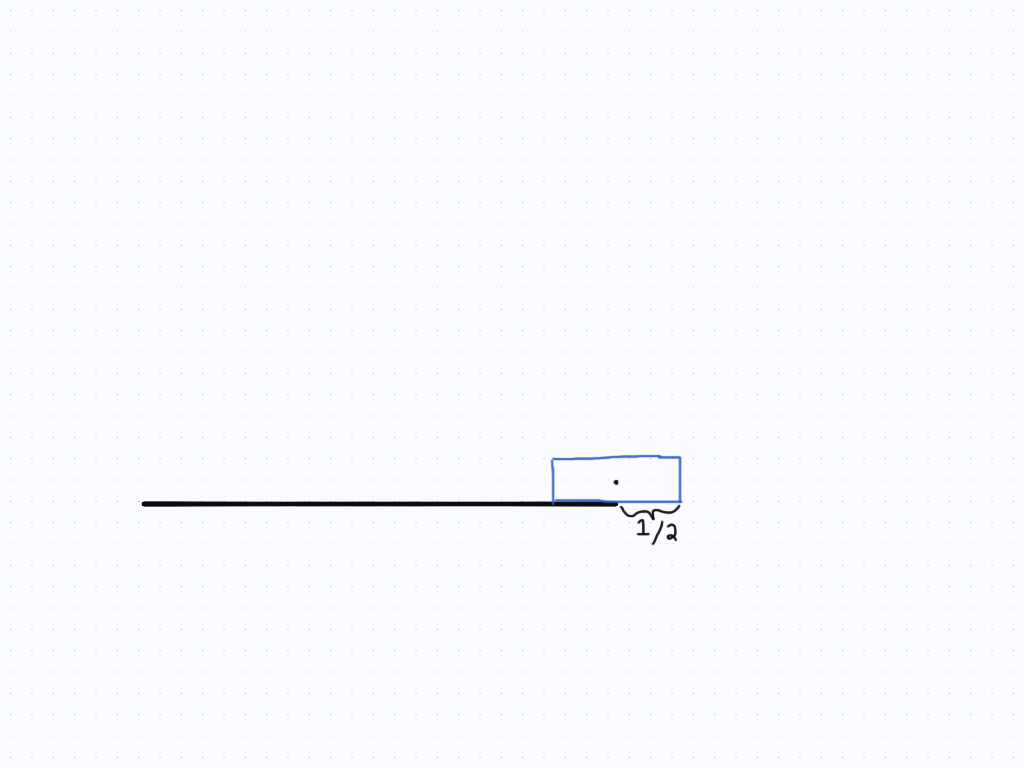
So that’s great, but now the logical extension to this question comes up. If I place a book underneath my first one, such that I now have two books, what kind of overhang can I get? Furthermore, can I keep on adding books to make the “path” longer and longer, and when will it fall?
It turns out that this is a problem that many people have thought about before. In fact, there are a number of varieties to this problem, usually dependent on how one goes about adding the books. In this case, let’s focus on the simplest case. We will continually add books of the same size and mass, one by one. We want to see when the whole structure will fall.
Ready? Let’s begin.
In Rhythm
We have a lot of choice with two blocks now. We can slip the second one under our original so most of it is still under the table. However, like we did for the case with one block, we may as well find the furthest point that will keep the structure stable (we want to be efficient with our block stacking).
From our analysis with only block, we know that the structure will fall once the centre of mass passes the edge of the table. Therefore, we don’t want that to happen. We will keep our initial block with an overhang of $1/2$ (since that’s the maximum it can be at before the block falls), and will decide how to place the second block on the table. First, we should note that both block have their centre of mass in their geometric centres, represented by the black dots on the diagrams. Additionally, we now care about their combined or common centre of mass, since if that is further out than the edge of the table, the blocks will fall.
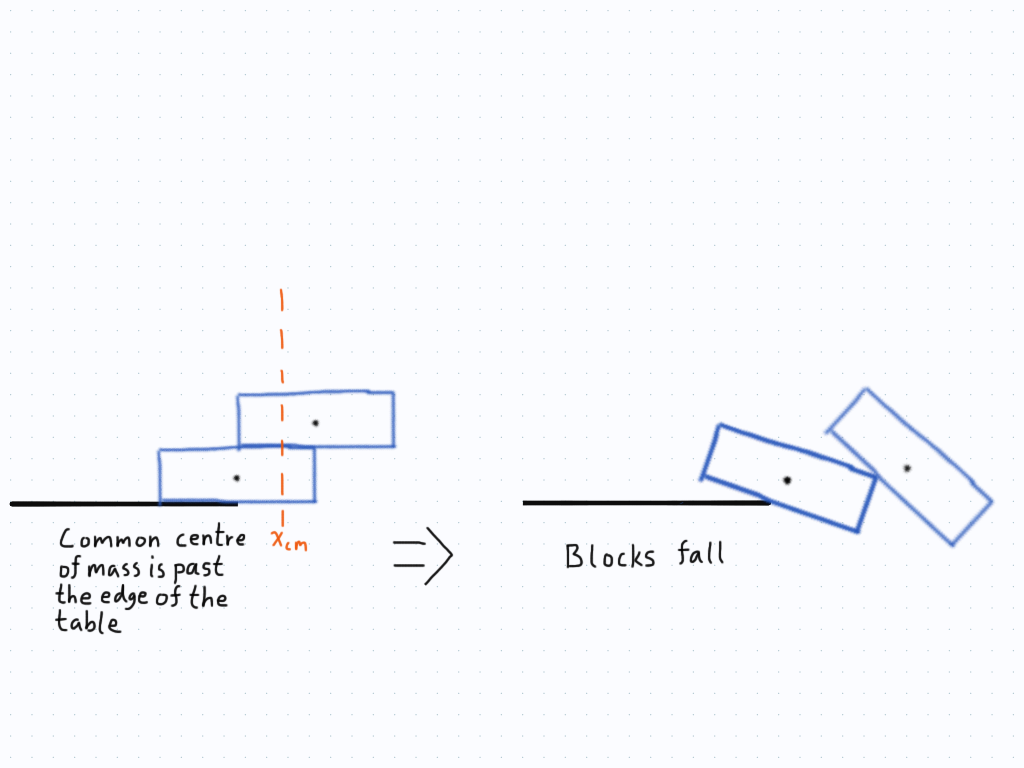
To find this centre of mass, consider the fact that the top block has an overhang of $1/2$, and so the two blocks look like this:
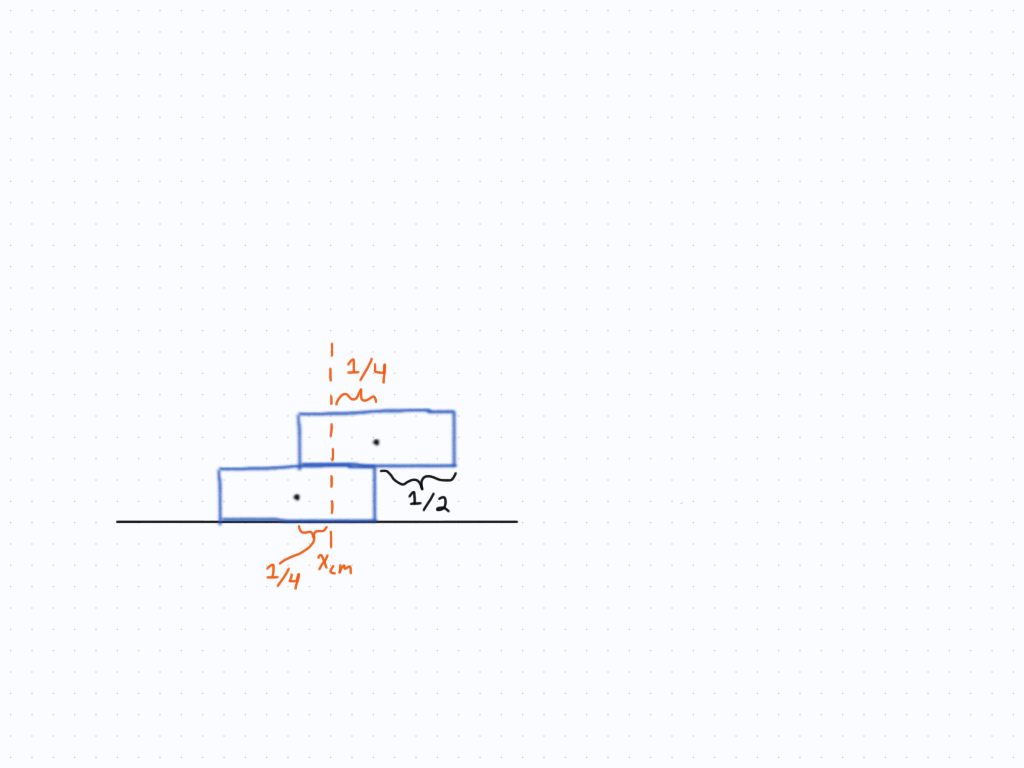
From the diagram, we can see that the common centre of mass of both blocks will be somewhere in between the centre of masses of each respective block. This corresponds to somewhere within the overlapping sections of the blocks. However, since the overlapping section is exactly half of each block, and the density of each block is constant, we can use an argument by symmetry to say that the common centre of mass is directly in the middle of the centre of masses of each block. This is because the rest of the mass is distributed exactly evenly to the left and the right of that point. Note that I’m only talking about the $x$-coordinate of the centre of mass, which is all we care about in this problem. As such, the centre of mass for our new structure is given by placing the bottom block such that it has an overhang of $1/4$. As shown below.
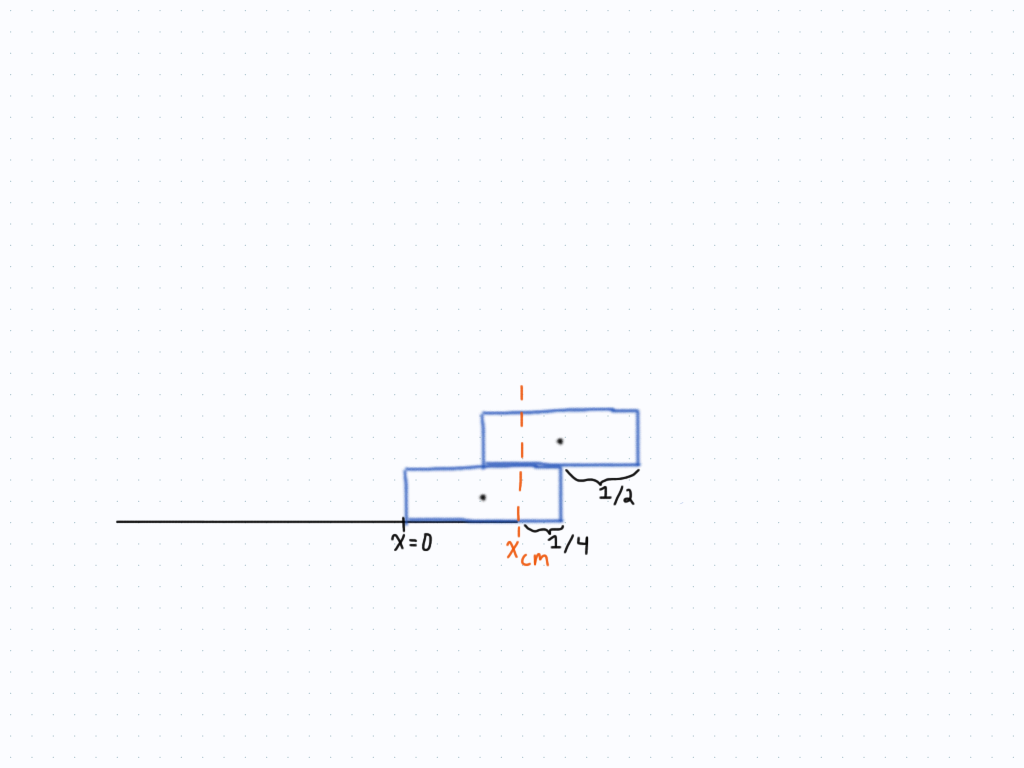
We then want to repeat the procedure with a third block, and see if we can notice a pattern. Three blocks is slightly more tricky, but not too bad. Once again, we place the third block underneath the previous two such that the overhang of the top two blocks begins at their centre of mass. This is much easier seen in a sketch.
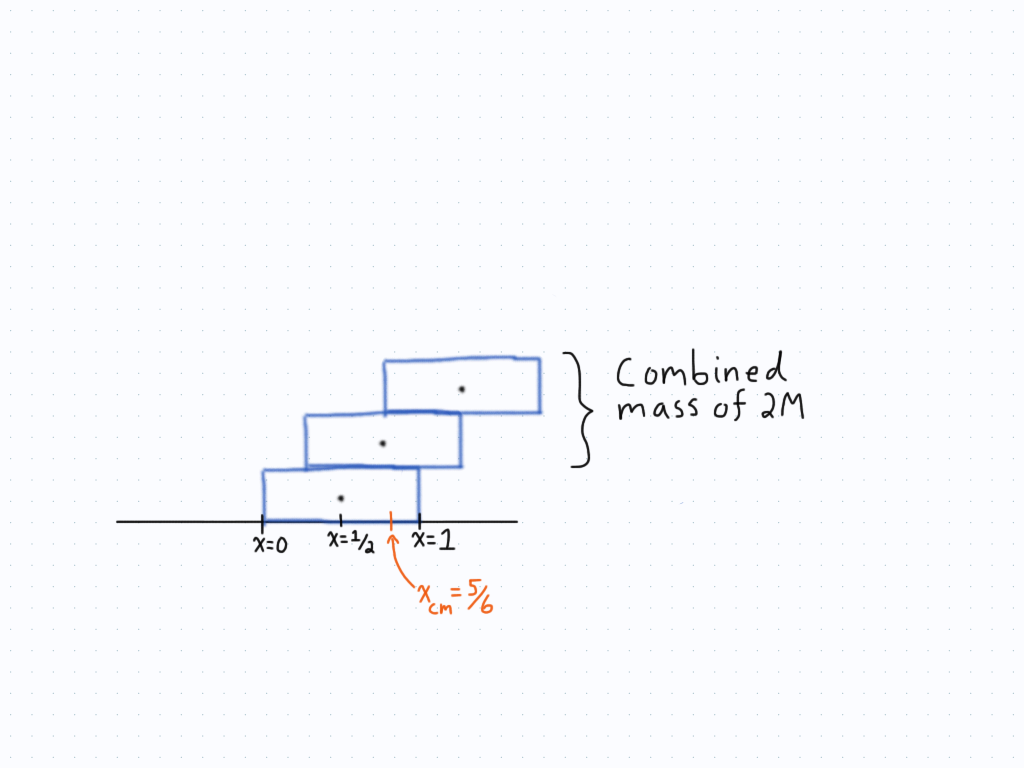
We can now consider the two blocks that we have analyzed previously to have a “total” mass of $2M$ and a common centre of mass located at 1 unit from the diagram above. The bottom block has a centre of mass located at $1/2$ a unit from the zero point, which begins at the left end of the bottom block. Therefore, the common centre of mass for the three blocks is given as:
\(x_{cm} = \frac{(2M)(1)+(\frac{1}{2})M}{2M + M} = \frac{5}{6}.\)
As such, if we want to place the common centre of mass on the edge of the table, we need to make the third block have an overhang of $1-5/6 =1/6$.
Now that we’ve looked at the three first steps, let’s see how much overhang we get for each new block added. With one block, the overhang is $1/2$. For two blocks, we get an extra $1/4$, which makes for a total of $\frac{1}{2} + \frac{1}{4} = \frac{3}{4}$. For three blocks, we get another $1/6$, which makes for a total of $\frac{1}{2} + \frac{1}{4} + \frac{1}{6} = \frac{11}{12}$.
Do you notice a pattern? If we factor out a half from each term, we get the fractions $1/1$, $1/2$, and $1/3$ for each new block added. As such, if we generalize this progression for when we have $n$ blocks, we should expect something like this for the amount of overhang $d_n$:
\(d_n = \frac{1}{2} \left[ \frac{1}{1} + \frac{1}{2} + \frac{1}{3} + \ldots + \frac{1}{n} \right].\)
Note that this can be proved by induction. We will prove this in terms of how much overhang the $n^{th}$ block will have, which is given by $D_n = \frac{1}{2n}$. For the first case with $n=1$, we see that $D_1 = 1/2$, which is exactly what we expect. For the induction hypothesis, we say that the overhang for block $k$ will be $D_k = \frac{1}{2k}$. Now, let’s consider the structure with $k+1$ blocks. From above, we’ve seen that our strategy is to align the edge of the new block with the combined centre of mass of the structure above it. A sketch helps to see this.
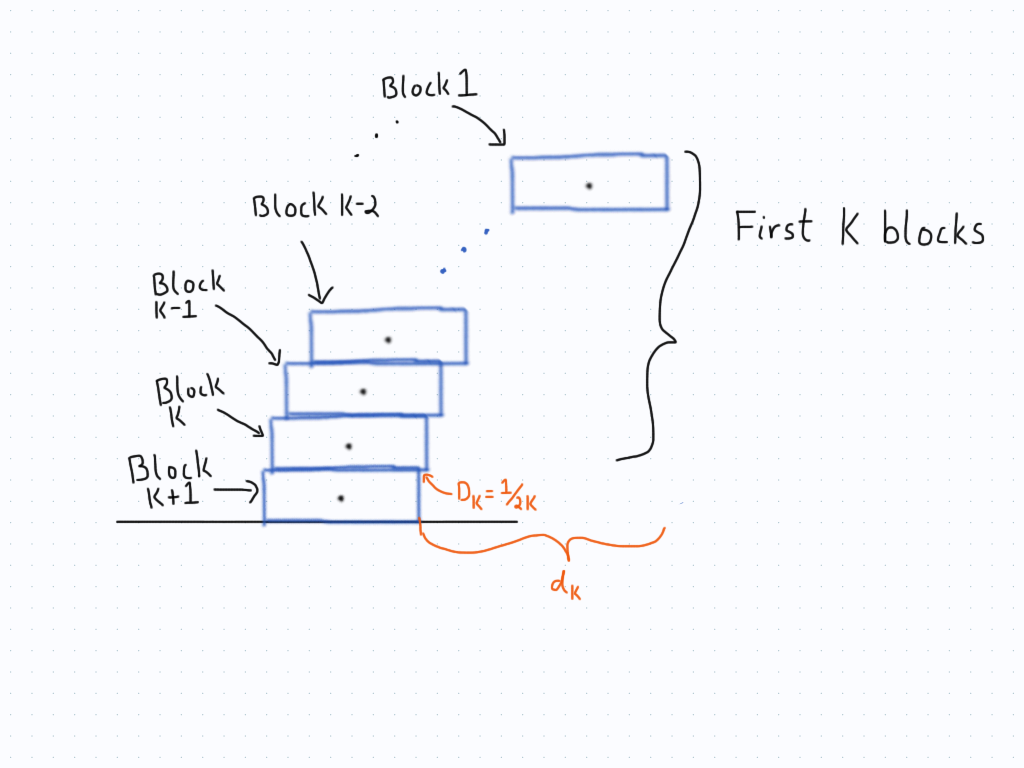
You can see that the amount of overhang that the structure with $k$ blocks has compared to the $k+1$ block is given by $D_k$, our induction hypothesis. If we then take the zero point to be at the left end of the $k+1$ block, geometry tells us the the centre of mass of the structure of $k$ blocks is exactly $1$ unit away. Additionally, the combined mass of that structure is $kM$, since there are $k$ blocks. Finally, the last block has a mass of $M$ and a centre of mass of $1/2$, like usual. Therefore, we can calculate the centre of mass for the $k+1$ blocks to be:
\(x_{cm} = \frac{(kM)(1) + \left( \frac{1}{2} \right) (M)}{kM + M} = \frac{k + \left( \frac{1}{2} \right)}{(k+1)} = \frac{2k + 1}{2k+2}.\)
To find out how much overhang there is, we simply align the centre of mass to the edge of the table. Since the total length of the bottom block is one, the overhang for the $k+1$ block is given by:
\(D_{k+1} = 1 - \frac{2k + 1}{2k+2} = \frac{1}{2(k+1)}.\)
And, this completes the induction. Therefore, the $n^{th}$ block will have an overhang of $1/2n$. Furthermore, the total overhang si given by simply adding up the overhang of each individual block, which gives us our sum up above.
At first glance, this sum looks like it will plateau quickly. As $n$ gets larger, each successive term gets smaller and smaller. For $n=100$, the extra distance on the overhang is only an extra $0.01$. This only gets smaller for larger $n$, so it makes sense to think this sum will reach a certain point in which nothing really gets added to the total. But how can we show this?
In mathematics, the above expression for $d_n$ is called a partial sum. It’s called a partial sum because “real” sums are infinite series, the result of adding terms as $n$ approaches infinity. We have tools to deal with what happens when $n$ gets closer to infinity, and it allows us to deal with our expression here. If we can actually take this limit and get a finite answer (one that isn’t infinity), then we will have found the maximum overhang possible.
Before we tackle this question, let’s go through a quick example of infinite series and how they can indeed give a non-infinite answer, even after adding infinitely many terms. Imagine you have to cross a room, and you say that the length of the room is one unit long. Then, in order to get to the other side of the room, you first have to cross half of the room. You then have to cross a half of that remaining distance, which is a quarter of the whole distance. You then have to cross half of that remaining distance, which corresponds to an eighth, and so on. If we keep doing this for an infinite number of times, what should be the total distance traveled?
To answer this, remember that the total distance of the room is one unit. Therefore, if you do an infinite number of those small steps as you go across the room, it stands to reason that by the end of it all, you will have crossed the room! Putting this into mathematics, it means that we get the following:
\(\frac{1}{2} + \frac{1}{4} + \frac{1}{8} + \ldots = 1.\)
Here, the ellipsis signifies that we are adding up all the terms, every single one. Historically, this is known as Zeno’s paradox. The idea was that, if you always had to cover another half of whatever remaining distance there was, you’d never quite get to the end, since you’re always just a smaller and smaller distance away from your end goal. However, if you try to cross a room, you know that you will get there in the end. So the paradox is resolved by the fact that if you do an infinite number of steps (and not just a lot), you do indeed get to the other side. As such, the infinite series that is shown above does indeed go to one.
But what about ours? We have $ \frac{1}{2} \left[ \frac{1}{1} + \frac{1}{2} + \frac{1}{3} + \ldots + \frac{1}{n} \right]$, which is a bit of a different series. This one is not quite the same flavour as the previous one. In fact, the series which is within the brackets is actually known as the harmonic series, and is well known in mathematics. To figure out if the series adds up to a finite number (we say that the series “converges”) or goes to infinity (we say that the series “diverges”), we can compare it to another series, in which every denominator gets changed to the next largest power of two. We will only compare the series (which is the terms in the brackets). As such, we get our original series, and the new one, which looks like:
\(\left[ \frac{1}{1} + \frac{1}{2} + \frac{1}{3} + \frac{1}{4} + \frac{1}{5} + \frac{1}{6} + \frac{1}{7} + \frac{1}{8} + \ldots \right],\)
and
\(\left[ \frac{1}{1} + \frac{1}{2} + \frac{1}{4} + \frac{1}{4} +\frac{1}{8} + \frac{1}{8} + \frac{1}{8} + \frac{1}{8} + \ldots \right].\)
If you look closely, the first series should clearly be larger than the second one, since the denominators are smaller than or equal to the corresponding terms in the second series. But if we group the terms in the second series, we get something interesting:
\(\left[ \frac{1}{1} + \frac{1}{2} + \left( \frac{1}{4} + \frac{1}{4} \right) + \left( \frac{1}{8} + \frac{1}{8} + \frac{1}{8} + \frac{1}{8} \right) + \ldots \right].\)
Simplifying this is nice, since all of the terms in the parentheses are $1/2$. Furthermore, since this trend continues, the sum is simply the result of adding a bunch of halves together. If we keep on adding the same number to itself for an infinite number of times, the series will diverge. The only exception to this is zero, which will converge to zero. But the number here is $1/2$, so the series will diverge and grow indefinitely. Consequently, since we said that the series we are interested in is bigger than this series that diverges, our series has to also diverge! Think about it: the only way to be larger than infinity is if it’s also a series that diverges. Therefore, we can conclude that our series $d_n$ (which is just the series we were talking about above, scaled by $1/2$) diverges.
This is not something you would expect. Think about the consequence of this result. If $d_n$ grows indefinitely, then one can keep on stacking books in just the right way such that the overhang is infinite! We can reach from your table to your neighbouring town, without it the stack ever falling.

Physically, this means that, despite having the books reaching as far away from your table as you would like, the centre of mass of the whole structure still won’t pass the edge of the table. In my eyes, this is pretty incredible. We just came up with a structure that can hold itself over an edge for an infinite distance. That’s not something you’d exactly expect when asked.
Wait a second
“But this is ridiculous,” you might say. “We can’t actually do this. I can’t even get a structure going for one metre of overhang! What’s the catch?”
Of course there’s a catch.
First, we need to remember our assumptions. We started with the fact that the only forces acting on the books are gravity and the normal force. However, this obviously neglects the fact that air is present in the room, that there are other disturbances which could ruin this stacking. Additionally, one has to be exact in the placement, since having any block being a bit too far will cause the whole structure to collapse. As such, this is far worse than trying to create a long line of dominoes.
We also assumed that every block has exactly the same mass, is rigid, and has exactly the same dimensions, which isn’t exactly a reasonable assumption for something in real life. Still, it makes the mathematics of the problem easier, so we go with it.
The other big issue with this stacking is that it grows very slowly. In fact, the harmonic series is distinct in its slow growth. It turns out that the harmonic lies right on the border between series of the form $\frac{1}{n^a}$ which will diverge (when $a \lt 1$), and those that will converge ($a \gt 1$). To give you an idea of how slow this series grows, if we stack thirty identical books with this method, the resulting overhang is $d_{30} \approx 1.99749$. Therefore, thirty books doesn’t even net you two book lengths of overhang. But it gets worse, since the numbers only grow more slowly as $n$ gets large. If you take a thousand books, you get an overhang of $d_{1000} \approx 3.74274$. You can see that this isn’t exactly a fast process. By adding $970$ books, we still can’t even double the length we had for $30$ books.
So the stacking process is extremely slow. And that’s kind of the amazing part. Even though the process is so slow (and gets to be essentially as slow as you want), the structure can get as large as you’d like. I like to think of it as an “unstoppable force meets an immovable object” scenario. In this case though, the structure can grow forever, and so the slowness of the building process does not stop it.
Want to know what this structure looks like as the number of books gets large? Well, here you go.
](/images/overhang/bookStacking.gif)
You can see that the structure grows vertically quite quickly, while it’s horizontal movement is relatively slow. This means that getting any meaningfull amount of overhang in real life will be tedious. Still, if done the right way, and with the right materials, it should be possible. I won’t be trying it anytime soon, but if you want to take a crack at it, by all means go for it and share the results.
Smarter stacking
Throughout all of this, you might have been wondering something along the lines of, “This is a stupid way to stack the blocks. I want to stack them such that I can get a counterweight to balance the whole structure.”
And, you’re absolutely right. There are plenty of other ways to stack the blocks, depending on the rules you want to follow. Above, we followed the implicit rule that each block had to be on its own “level”. In other words, there can be only one block directly on top of the first block. As such, you can’t build an inverted pyramid type of structure, since that requires having more than one block per level. If we relax our rules though, we can then easily look at these more complicated situations. It’s all a matter of what we want our rules to be. The Wikipedia page has some details on variations of book stacking, and you can see what the other strategies look like. But that’s enough for now. You’re armed with a strategy to stack blocks and create an overhang to infinity and beyond without ever making the stack fall.